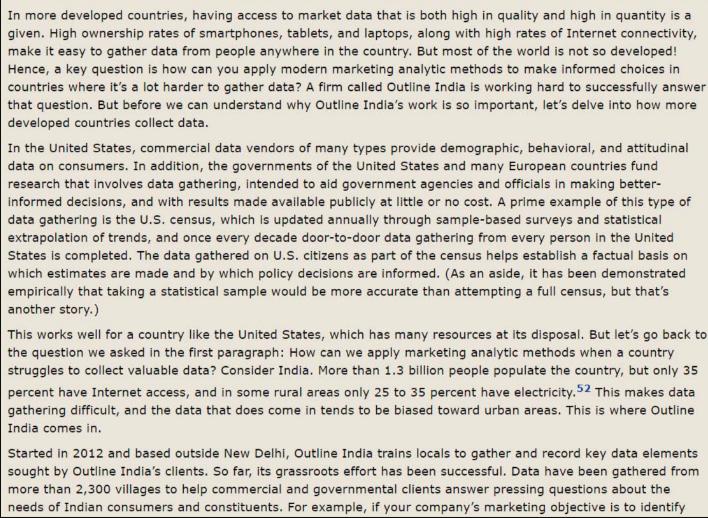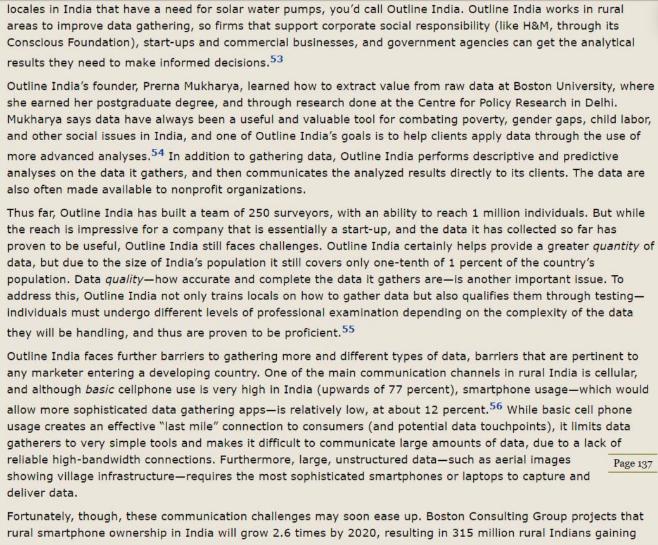Answered step by step
Verified Expert Solution
Question
1 Approved Answer
In more developed countries, having access to market data that is both high in quality and high in quantity is a given. High ownership




In more developed countries, having access to market data that is both high in quality and high in quantity is a given. High ownership rates of smartphones, tablets, and laptops, along with high rates of Internet connectivity, make it easy to gather data from people anywhere in the country. But most of the world is not so developed! Hence, a key question is how can you apply modern marketing analytic methods to make informed choices in countries where it's a lot harder to gather data? A firm called Outline India is working hard to successfully answer that question. But before we can understand why Outline India's work is so important, let's delve into how more developed countries collect data. In the United States, commercial data vendors of many types provide demographic, behavioral, and attitudinal data on consumers. In addition, the governments of the United States and many European countries fund research that involves data gathering, intended to aid government agencies and officials in making better- informed decisions, and with results made available publicly at little or no cost. A prime example of this type of data gathering is the U.S. census, which is updated annually through sample-based surveys and statistical extrapolation of trends, and once every decade door-to-door data gathering from every person in the United States is completed. The data gathered on U.S. citizens as part of the census helps establish a factual basis on which estimates are made and by which policy decisions are informed. (As an aside, it has been demonstrated empirically that taking a statistical sample would be more accurate than attempting a full census, but that's another story.) This works well for a country like the United States, which has many resources at its disposal. But let's go back to the question we asked in the first paragraph: How can we apply marketing analytic methods when a country struggles to collect valuable data? Consider India. More than 1.3 billion people populate the country, but only 35 percent have Internet access, and in some rural areas only 25 to 35 percent have electricity, 52 This makes data gathering difficult, and the data that does come in tends to be biased toward urban areas. This is where Outline India comes in. Started in 2012 and based outside New Delhi, Outline India trains locals to gather and record key data elements sought by Outline India's clients. So far, its grassroots effort has been successful. Data have been gathered from more than 2,300 villages to help commercial and governmental clients answer pressing questions about the needs of Indian consumers and constituents. For example, if your company's marketing objective is to identify locales in India that have a need for solar water pumps, you'd call Outline India. Outline India works in rural areas to improve data gathering, so firms that support corporate social responsibility (like H&M, through its Conscious Foundation), start-ups and commercial businesses, and government agencies can get the analytical results they need to make informed decisions.53 Outline India's founder, Prerna Mukharya, learned how to extract value from raw data at Boston University, where she earned her postgraduate degree, and through research done at the Centre for Policy Research in Delhi. Mukharya says data have always been a useful and valuable tool for combating poverty, gender gaps, child labor, and other social issues in India, and one of Outline India's goals is to help clients apply data through the use of more advanced analyses. 54 In addition to gathering data, Outline India performs descriptive and predictive analyses on the data it gathers, and then communicates the analyzed results directly to its clients. The data are also often made available to nonprofit organizations. Thus far, Outline India has built a team of 250 surveyors, with an ability to reach 1 million individuals. But while the reach is impressive for a company that is essentially a start-up, and the data it has collected so far has proven to be useful, Outline India still faces challenges. Outline India certainly helps provide a greater quantity of data, but due to the size of India's population it still covers only one-tenth of 1 percent of the country's population. Data quality-how accurate and complete the data It gathers are-is another important issue. To address this, Outline India not only trains locals on how to gather data but also qualifies them through testing- Individuals must undergo different levels of professional examination depending on the complexity of the data they will be handling, and thus are proven to be proficient. 55 Outline India faces further barriers to gathering more and different types of data, barriers that are pertinent to any marketer entering a developing country. One of the main communication channels in rural India is cellular, and although basic cellphone use is very high in India (upwards of 77 percent), smartphone usage-which would allow more sophisticated data gathering apps-is relatively low, at about 12 percent. 56 While basic cell phone usage creates an effective "last mile" connection to consumers (and potential data touchpoints), it limits data gatherers to very simple tools and makes it difficult to communicate large amounts of data, due to a lack of reliable high-bandwidth connections. Furthermore, large, unstructured data-such as aerial images Page 137 showing village infrastructure-requires the most sophisticated smartphones or laptops to capture and deliver data. Fortunately, though, these communication challenges may soon ease up. Boston Consulting Group projects that rural smartphone ownership in India will grow 2.6 times by 2020, resulting in 315 million rural Indians gaining the ability to communicate their needs to marketers and companies like Outline India.57 In the end, no matter what obstacles it faces, Outline India strives to provide a large quantity of high-quality field data to help inform the decisions of policymakers and companies, which will ultimately continue to positively impact the population of India. Outline India's end goal is to use data gathering and data analysis to improve the lives of many rural Indians. Questions Identify & discuss at least 3 external market environmental factors that impact Outline India's ability to collect data. Discuss the global strategy of Outline India. What are their expectations regarding reliability, quality & range of services? Provide at least two viable courses of action to ensure that Outline India is able to collect large amounts of complete and reliable data.
Step by Step Solution
★★★★★
3.32 Rating (161 Votes )
There are 3 Steps involved in it
Step: 1
The detailed answer for the above question is provided below ANSWER Three external market environmental factors that impact Outline Indias ability to collect data are 1 Infrastructure limitations In r...
Get Instant Access to Expert-Tailored Solutions
See step-by-step solutions with expert insights and AI powered tools for academic success
Step: 2

Step: 3

Ace Your Homework with AI
Get the answers you need in no time with our AI-driven, step-by-step assistance
Get Started


